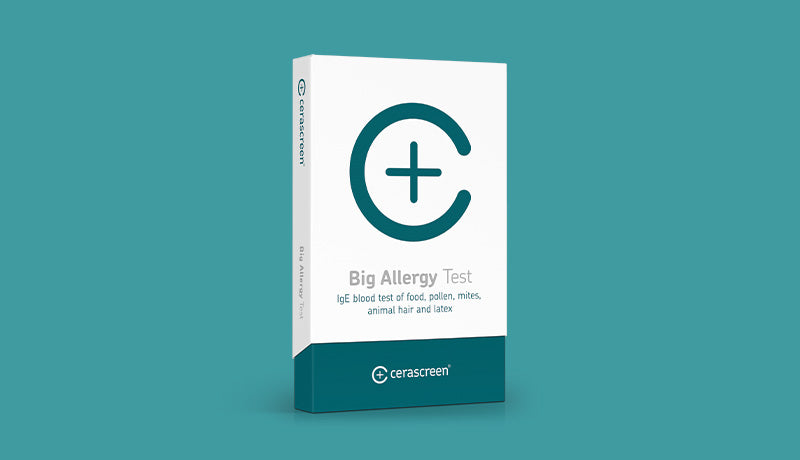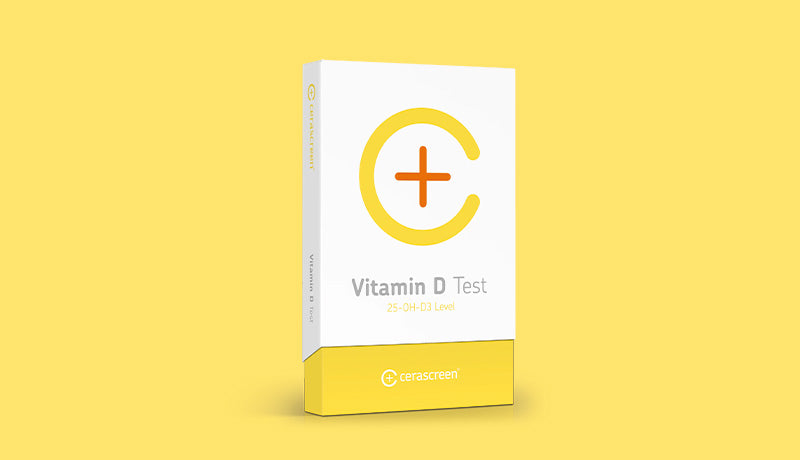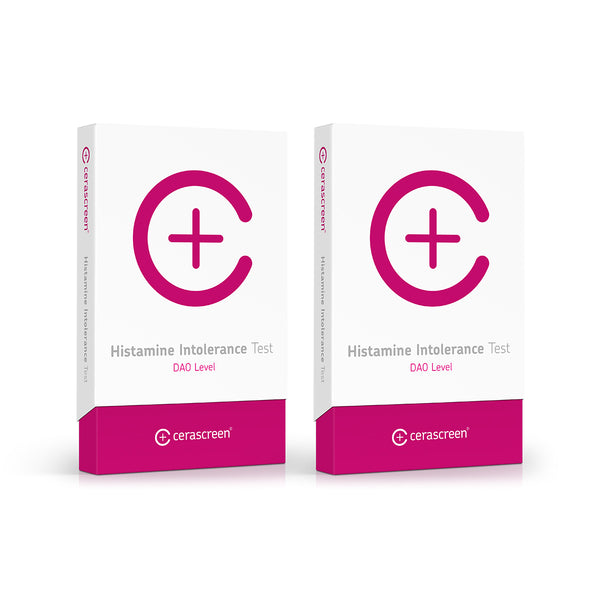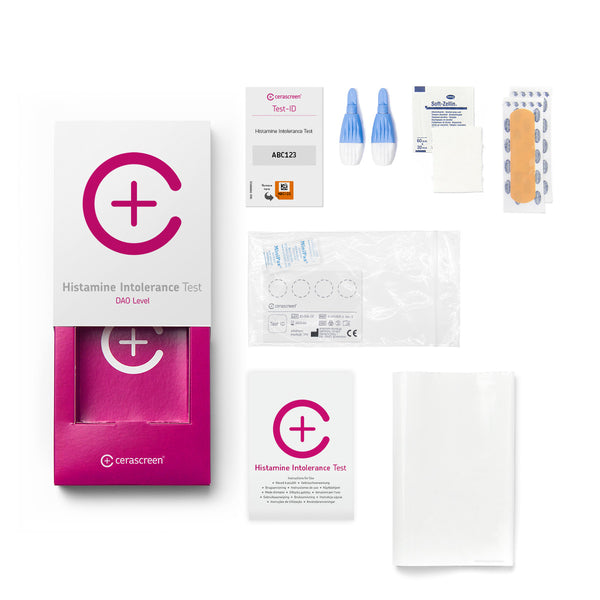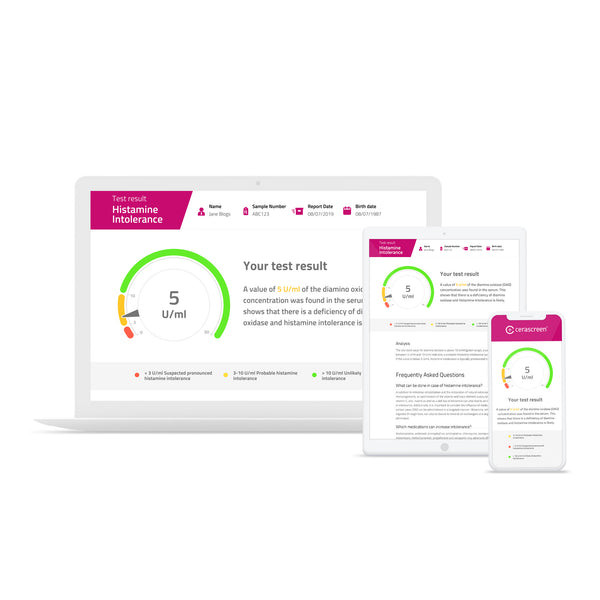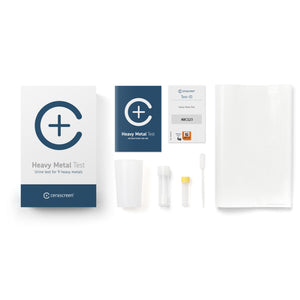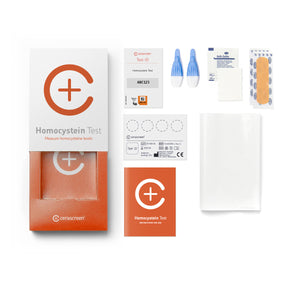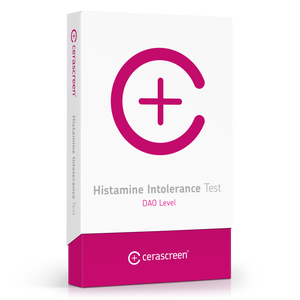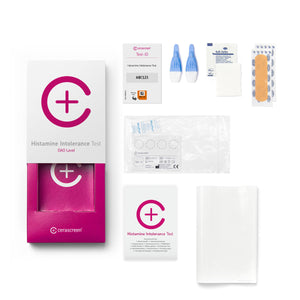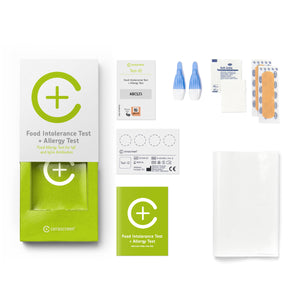product_id = 6586003816507variant_id = 39419839840315template_name =

2x Histamine Intolerance Test
About the test
Did you know that headaches, nausea, irregular heart rate, abdominal pain, gas and skin rashes as well as itching may all be signs of histamine intolerance?
Histamine Intolerance is intolerance of histamine consumed through food. It is caused by a deficiency in the histamine-degrading enzyme diamine oxidase (DAO) or by an imbalance of histamine and DAO. As far as experts are concerned, it is not normally caused by genetic factors; it is often known to be associated with another health condition.
With the cerascreen® Histamine Intolerance Test Double Pack, you can determine the concentration of the enzyme diamine oxidase (DAO), which breaks down histamine in your intestine, in your blood with a blood sample. A low value of DAO can confirm histamine intolerance. You will receive a results report with information and recommendations on how to follow a low-histamine diet and boost your intestinal health.
2x Histamine Intolerance Test
- Save now by purchasing the Histamine Intolerance Test as Double Pack
- Take your sample at home – conveniently and discreetly
- Receive a state-of-the-art laboratory analysis
- Benefit from specific recommendations to live with a histamine intolerance
- Please note: Expect to receive the results report within a few weeks due to the current situation.
Benefits of the 2x Histamine Intolerance Test
Once you have found out that you cannot tolerate too much histamine, you can take your health into your own hands. If you change your diet and avoid certain medications, with a bit of luck, your symptoms will go away.
The cerascreen® Histamine Intolerance test is carried out by our specialist medical laboratory, without waiting times or doctor's visits. You can take your sample discreetly and comfortably at home. The professional analysis is carried out by our medical partner laboratory.
Benefit from our expertise: cerascreen® is the market leader for medical sampling and submission kits in Europe, with eight years of experience in test development and analysis. We have developed more than 50 approved send-in test kits (medical devices), evaluated 250,000 samples and serve 19 countries in Europe – and the United States.

Result of the 2x Histamine Intolerance Test
As soon as your sample has been analysed, you will receive your results report via the My cerascreen® app or your user account on our website. You can easily view the report on your smartphone, tablet or computer and print it out, if required.
Find out the concentration of diamine oxidase (DAO) in your blood in the laboratory analysis. Learn how to adjust your diet to a histamine intolerance through clear recommendations for action. You will also receive comprehensive health information explaining the symptoms and treatment options.
Frequently asked questions about 2x Histamine Intolerance Test
Why take the Histamine Intolerance Test?
Histamine intolerance causes complaints all over the body in at least one percent of the UK population. Symptoms are often generic, ranging from stomach noises to headaches and skin rashes. The fact that histamine is found in many different foods – such as cheese, sausage, fish and red wine – makes avoiding histamine even more difficult.
A blood test for histamine intolerance is the first step you need to take for a diagnosis. If the test results indicate an intolerance, you can change your diet and reduce your intake of foods containing histamine. However, such a change in diet is not easy – there is a lot to consider if you want to avoid histamine as much as possible. That is why it is advisable to first take a test to confirm histamine intolerance.
Who should take the Histamine Intolerance Test?
People who suffer from allergy-like symptoms but have not been able to identify any allergies should take the Histamine Intolerance Test. Typical symptoms of histamine intolerance include gastrointestinal discomfort, skin rashes, runny nose and headaches.
You also belong to a risk group for histamine intolerance if you have chronic inflammatory bowel diseases such as Crohn’s disease or suffer from gastritis, irritable bowel syndrome or stomach ulcers.
Histamine intolerance is also more likely to affect people who regularly take medications such as painkillers, antidepressants and drugs for cardiac arrhythmias and other heart diseases.
How does the Histamine Intolerance Test work?
With a lancet, which is provided in the test kit, take a small amount of blood from your fingertip and collect the blood on the dried blood spot card provided. Then send the blood sample in the return envelope to our specialised laboratory.
In the two weeks before the test, you should eat a varied diet and, above all, not deliberately eat only low-histamine foods – otherwise, you will not get any useful results from the test.
Please note: You should do the test when you are healthy. Infections such as a cold or flu can affect the results, as can alcohol consumption. Certain medications also influence your values. You can find more information on how certain medicines can influence test results here in our FAQs.
How long does the analysis take in the laboratory?
Once your sample has arrived at the laboratory, it will be analyzed there by specialists. How long the analysis takes depends on the exact measuring method and the processes in the laboratory.
If the sample is sent on the correct days (Sunday to Tuesday), this makes it easier for the laboratory to adhere to the times.
For the Histamine Intolerance Test, the laboratory analysis is usually completed within 7 working days after the sample is received in the laboratory.
What does the results report tell me?
The results report tells you the concentration of the enzyme diamine oxidase (DAO) in your blood. This enzyme breaks down the histamine in your intestine. If your DAO value is too low, this can be an indication of histamine intolerance.
The report also tells you whether your DAO levels are healthy.
Which recommendations will I receive?
In your Histamine Intolerance Test results report, you will find a number of clear recommendations in addition to your test results.
You will learn, for example, how to avoid foods containing histamine, boost your gut health, optimise your vitamin and mineral levels and improve your symptoms through these measures.
Where does histamine intolerance come from?
Histamine is a messenger substance that is found in the human body and is involved in blood formation and wound healing, for example. Our immune system also needs histamine: the messenger substance triggers inflammatory reactions and thus fights pathogens.
We consume histamine through our diet. If our intestines and kidneys do not produce enough DAO, histamine cannot be broken down properly. This leads to histamine intolerance, where excess histamine can trigger inflammation and discomfort throughout the body.
There are a number of possible causes for the imbalance between enzymes and histamine:
– An unhealthy gut due to irritable bowel syndrome, gastritis, Crohn’s disease or intestinal ulcers
– A deficiency in vitamins and minerals, including vitamins B6 and C and zinc
– Certain medicines and alcohol
What are the signs of histamine intolerance?
The signs of histamine intolerance are similar to allergic reactions – because histamine also plays an important role in allergies, when the body then releases too much histamine and thus experiences inflammation. This is why histamine intolerance is often confused with an allergy.
Typical signs of histamine intolerance include redness and itching and swelling of the skin; stomach and intestinal cramps, flatulence and diarrhoea; a runny nose, cough, asthma and difficulty swallowing ; a headache and dizziness ; palpitations, increased blood pressure and cardiac arrhythmia.
If you suffer from these symptoms after eating, it is worthwhile taking a histamine intolerance test. A special three-phase diet can then confirm your suspicions.
How do I treat histamine intolerance?
With histamine intolerance, it is crucial that you eat a diet as low in histamine as possible. Histamine cannot be removed from food by heating, freezing or washing. Only a change in diet will help you: if your intestines only have to process a little histamine, this will alleviate any symptoms.
Other treatment methods include:
– Promoting gut health – probiotic foods, lots of fibre and little sugar help enzymes in your gut
– Vitamins and minerals – sufficient vitamin B6, vitamin C and zinc help your intestine process histamine
– Medication for acute symptoms – antihistamines can relieve inflammatory symptoms such as diarrhoea for a short time
Which foods contain histamine?
Histamine is found in many foods. People with histamine intolerance should avoid foods that contain large amounts of the substance, especially:
– Alcoholic drinks such as red wine, champagne, prosecco, wheat beer, aged spirits such as whisky and cognac
– Mature cheeses such as Parmesan, Emmental, Swiss cheese, Camembert
– Cured, smoked and dried meat and meat products
– Certain types of vegetables (spinach, tomato, avocado) and fruits (ripe banana, kiwi, strawberry, citrus fruits)
– Chocolate and cocoa
Which medications should I avoid if I’m intolerant to histamine?
Certain medicines are known for triggering or aggravating histamine intolerance symptoms, similar to histamine-containing foods. Such medicines often block the enzyme DAO or increase the release of histamine in the body.
These include, for example, painkillers with the active ingredients diclofenac, acetylcysteine and metamizole, and others, which are used to treat nausea and vomiting.
Please note: You should not stop taking medicines that you take regularly. Discuss this with your doctor first.
Why are children under 18 not allowed to take the test?
Our tests are not suitable for underage children and adolescents under the age of 18. Under 18s cannot activate the tests online and therefore cannot receive a test result. We ask that you do not administer the tests to your children either.
Children and adolescents need much closer supervision and counselling regarding medical tests and their interpretation. Testing with lancets and chemicals is not without risk and would need to be closely supervised by guardians. In addition, the reference values we give are always based on adult data. In the case of children, the risk of misinterpreting the results would be very high.
We want to fulfil our responsibility as a provider of medical products and ensure that children and adolescents are not unsettled by measurement results that are difficult for them to interpret. Since we cannot control whether the minors' legal guardians actually consent to the test being carried out and supervise them, we exclude tests for under 18s altogether.
If you are under 18 and have purchased a test, please contact our customer support.
Why does it take up to a week for the sample to reach the lab?
Please bear in mind that your results will not be analyzed in the UK but in Germany. For that reason, it can take up to a week for the sample to arrive at the lab. This does not affect the stability of the samples, as the method we are using is optimized for long transports.
Initially, your sample is sent to our collection center in the UK. From there, it is shipped to our central sample sorting facility in Germany, which then distributes samples to our partner laboratories. Once your sample is analyzed there, you will receive a notification and can access your result online.
Please check your mailbox regularly. We will notify you as soon as your sample is sent, arrives, or is analyzed.
This is how it works
1. Test at home
Your test kit contains everything you need to draw a small sample of blood from your fingertip. Then send the sample back to us free of charge in the enclosed return envelope.
2. View results online
After the evaluation in the medical specialist laboratory, you will have online access to your personal result report.
3. Act
Your access to the test results and the evidence-based findings and tips to improve your health: the my cerascreen® user profile on our website or our app.
